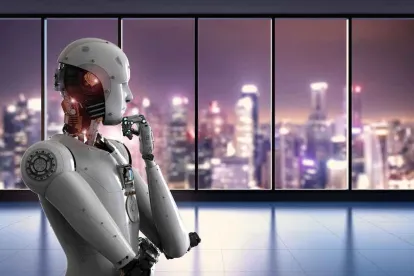Artificial Intelligence and the Creative Process
Computers, robots, and machines have played a role in the creative process for generations, producing crude images or outputs that artists use, tweak, or start from to create original works of art. David Bowie famously used a machine called the Verbasizer to generate random words and spark ideas for song lyrics on his 1995 album Outside.
More recently, the rise of artificial intelligence (AI) has picked up steam, requiring us to rethink the role of AI in the creative process. Machines that once produced crude images have now been replaced with autonomous computer programs that are capable of learning without being continuously re-programmed or updated by humans. Today, anyone can visit an AI program, input a few words or descriptions, and with the push of a button create sophisticated, AI-generated works of art.
Implications for Copyright Law
Creating AI-generated art could have important implications for copyright law. Traditionally, copyright ownership in computer-generated works was not in question because the program was only a tool that supported the creative process, such as using Microsoft Word to write a novel. But with AI programs, the program is no longer only a tool—it now makes many of the decisions involved in the creative process without human intervention to create AI-generated works of art.
There are three ways in which U.S. copyright law could conceivably deal with creative works that are made with little to no human involvement. Regulators can deny copyright protection outright for such works. They can grant copyright protection and attribute authorship to the programmer who created the generative AI program. Or they can grant copyright protection and attribute authorship to the end user who input text, ideas, music, or images into the AI program to generate the creative work in question (or perhaps some combination of the above).
Commercial Implications for Artists, Programmers and End Users
The decision regulators make will have profound commercial implications for artists, programmers, and end users. Whether regulators like it or not, AI is already being used to produce creative works in many fields. Visual art, written works, musical compositions, and even video games are being created with the assistance of AI programs.
If regulators decide AI-generated works are not eligible for copyright protection, then companies and programmers that have invested in the technology and that want to profit from those works will be out of luck. Imagine if Microsoft invested millions in an AI program that creates music, only to find out that the music is not eligible for copyright protection and can be freely used by anyone in the world? Or consider a scenario where Google invested heavily in an AI program that created the next “Lord of the Rings” novels, but could not profit from the worldwide sensation?
Conversely, if regulators decide AI-generated works are eligible for copyright protection, those AI companies will profit considerably—and perhaps even at the individual artists’ expense. Take, for example, a popular recording artist like Taylor Swift whose music is hypothetically scraped from Spotify and used to create a new, AI-generated hit song. Would Swift be within her rights to bring a copyright infringement lawsuit against the distributor of that song? She would certainly be missing out on oodles of royalties from the song, which might have copied melodies, rhythms, and clever lyrics that are characteristic of her style and sound. So, should artists like Swift be the unlucky ones?
Then there is the end user who input text, images, sounds or other data points into the AI program to generate a creative work. Should the end user be entitled to copyright protection to the exclusion of both the programmer and the artist(s) upon which the new, AI-generated work might be based? It is unclear. It may ultimately depend upon how involved the end user is in creating the inputs. On the one hand, if the AI-generated art is created with just a few words plugged into the program, it is unlikely the resulting art would be entitled to protection. On the other hand, there could be instances where the end user deploys highly involved and thought-out processes to create inputs and tweaks the finished art, suggesting a higher degree of human involvement and perhaps even entitlement to copyright protection.
‘Creative Regulators’ and Artists Fight Back
The U.S. Copyright Office and the World Intellectual Property Organization (WIPO) are taking a hard look at the role of AI in copyright law. They are considering pressing questions about relationship between AI and copyright; the level of human input necessary for copyright protection; the legal challenges and considerations for using copyrighted works to train AI programs; and the legal and commercial implications of future AI and copyright policies. Just last month, the U.S. Copyright Office made its position clear: AI-generated creative works are not protectible under current U.S. copyright law because they “are not the product of human authorship.” On Feb. 21, the U.S. Copyright Office partially cancelled a copyright registration for the comic book “Zarya of the Dawn.” The author, Kris Kashtanova, created the images for the comic book with the help of an AI program called Midjourney. Although Kashtanova was allowed to maintain her copyright to the comic book’s “text, as well as the selection, coordination, and arrangement of the comic book’s written and visual elements,” she could not maintain a copyright in the individual images because they were not the product of human authorship. In so holding, the Copyright Office made clear that human involvement is critical for copyright protection.
The U.S. Copyright Office’s cancellation letter can be found here.
Artists are taking notes and pushing back against what they see as unfair copying of their creative works. Recently, a group of artists sued three AI companies—Stability AI, Midjourney, and Deviant Art—claiming that the companies’ AI programs violate U.S. copyright law by scraping their creative works from the internet without their consent, and using those works to create similar, AI-generated art. See Andersen v. Stability AI, Civil Action No. 3:23-cv-00201 (N.D. Cal.). Whether the AI companies are infringing on the artists’ copyrights by scraping their art from the internet and using it to not only train the AI programs but also to generate new art, however, is a complicated question that will need to be settled in the courts. In the meantime, these artists face the real risk of having a large portion of their market replaced by AI images that can be made with the push of a button. There is much to lose.
Programmers and End Users’ Defenses
Programmers and end users are not without any defenses. Many argue that use of AI programs to generate creative works should be considered fair use. The defense of fair use is a hallmark of copyright law. It is designed to address the fact that unauthorized use of another’s work is sometimes not actionable because it is deemed “fair.” In doing so, it alleviates a rigid approach to copyright law that might actually stifle the very creativity those laws are designed to foster. In other words, it permits some unauthorized use so that others can use and build upon prior works in a manner that does not unfairly deprive prior copyright owners of the right to control and benefit from those works.
Courts typically analyze four factors when deciding whether use of another’s work constitutes nonactionable fair use: the purpose and character of the use, including whether the use is of a commercial nature or is for nonprofit educational purposes; the nature of the copyrighted work; the amount and substantiality of the portion used in relation to the copyrighted work as a whole; and the effect of the use upon the potential market for or value of the copyrighted work. Fair use, however, is scrutinized on a case-by-case basis and is unlikely to render sweeping changes in copyright law when it comes to AI-generated art.
For now, some believe that scraping prior art for AI training purposes might be considered fair use, whereas the actual generation of AI art based on artists’ prior works may not be fair. Time will tell.
Future Outlook
AI’s role in the creation of art, music, and other artistic works poses complex questions for everyone—from artists and end users, to tech companies, programmers, regulators and lawmakers. Everyone will have different, and at times competing, interests and arguments to either rely upon, defend, or attack the use of AI programs to generate creative works. The simple truth is that no one knows what’s next for AI and copyright. But we are excited for the ride.
In the meantime, here are critical questions that will need to be answered:
-
How much human involvement is necessary to obtain copyright protection?
-
Will the U.S. Copyright Office application procedure soon ask applicants to identify and disclaim AI-generated authorship? Will authors always be able to separate human authorship from AI authorship?
-
If the U.S. Copyright Office permits protection for creative works that are AI-generated, who owns the work?
-
If the U.S. Copyright Office permits copyright protection for creative works that are produced with little to no human involvement, will courts uphold those copyrights in cases of alleged copyright infringement?
-
Should artists whose works are scraped from the internet and used to train AI programs be permitted to sue AI companies for copyright infringement?
-
Should artists whose works are scraped from the internet and used to make new, AI-generated have any legal rights over the resulting AI-generated art?
-
Should there be restraints placed on AI companies’ scraping and data collection?
-
Should artists be allowed to opt out of AI companies’ scraping and data collection?
-
Should artists be compensated when their art is scraped by AI programs?
-
Should AI platforms be allowed to protect themselves from copyright infringement through terms of use, DMCA takedown, and other stringent anti-infringement policies?
-
Can we ultimately find a balance among artists, programmers, and end users that will benefit all parties when it comes to AI-generated art?
* Disclaimer: This article was written without the assistance of artificial intelligence. : )



 />i
/>i
